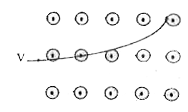Electron at rest are accelerated by a potential of V volt. These electrons enter the region of space having a uniform, perpendicular magnetic induction field B. the radius of the path of the electrons inside the magnetic field is
1B√mVe
1B√2mVe
VB
1B√ve
The correct Answer is:B
To find the radius of the path of electrons inside a magnetic field after being accelerated by a potential difference V, we can follow these steps:
Step 1: Calculate the Kinetic Energy of the Electron
When an electron is accelerated through a potential difference V, it gains kinetic energy given by:
KE=eV
where e is the charge of the electron.
Step 2: Relate Kinetic Energy to Velocity
The kinetic energy can also be expressed in terms of the mass m of the electron and its velocity v:
KE=12mv2
Setting the two expressions for kinetic energy equal gives:
eV=12mv2
Step 3: Solve for Velocity
Rearranging the equation to solve for v:
mv2=2eV⟹v2=2eVm⟹v=√2eVm
Step 4: Determine the Magnetic Force
When the electron enters the magnetic field B, it experiences a magnetic force given by:
F=qvB
For an electron, q=−e, so the magnitude of the force is:
F=evB
Step 5: Centripetal Force and Radius of Circular Motion
The magnetic force acts as the centripetal force that keeps the electron moving in a circular path. This centripetal force is given by:
F=mv2r
Setting the magnetic force equal to the centripetal force:
evB=mv2r
Step 6: Solve for the Radius r
Rearranging the equation to solve for the radius r:
r=mveB
Step 7: Substitute for v
Now substitute the expression for v from Step 3 into the equation for r:
r=m√2eVmeB
This simplifies to:
r=√2meVeB
Final Expression for the Radius
Thus, the radius of the path of the electrons inside the magnetic field is given by:
r=√2meVeB
When an electron is accelerated through a potential difference V, it gains kinetic energy given by:
KE=eV
where e is the charge of the electron.
The kinetic energy can also be expressed in terms of the mass m of the electron and its velocity v:
KE=12mv2
Setting the two expressions for kinetic energy equal gives:
eV=12mv2
Rearranging the equation to solve for v:
mv2=2eV⟹v2=2eVm⟹v=√2eVm
When the electron enters the magnetic field B, it experiences a magnetic force given by:
F=qvB
For an electron, q=−e, so the magnitude of the force is:
F=evB
The magnetic force acts as the centripetal force that keeps the electron moving in a circular path. This centripetal force is given by:
F=mv2r
Setting the magnetic force equal to the centripetal force:
evB=mv2r
Rearranging the equation to solve for the radius r:
r=mveB
Now substitute the expression for v from Step 3 into the equation for r:
r=m√2eVmeB
This simplifies to:
r=√2meVeB
Thus, the radius of the path of the electrons inside the magnetic field is given by:
r=√2meVeB
Topper's Solved these Questions
- MAGNETICBook:FIITJEEChapter:MAGNETICExercise:Assignment Problems (Assertion Reasoning Type)
Explore 2 Videos
- MAGNETICBook:FIITJEEChapter:MAGNETICExercise:Assignment Problems (Level - II)
Explore 20 Videos
- MAGNETICBook:FIITJEEChapter:MAGNETICExercise:Assignment Problems (Subjective) (Level - II & III)
Explore 15 Videos
- LAWS OF MOTIONBook:FIITJEEChapter:LAWS OF MOTIONExercise:COMPREHENSION-III
Explore 2 Videos
- MAGNETISMBook:FIITJEEChapter:MAGNETISMExercise:Example
Explore 12 Videos
Similar Questions
A charged particle having mass m and charge q is accelerated by a potential difference V, it flies through a uniform transverse magnetic field B. The field occupies a region of space d. Fnd the time interval for which it remains inside the magnetic field.
View SolutionAn electron accelerated through a potential difference V passes through a uniform tranverses magnetic field and experiences a force F. If the accelerating potential is increased to 2V, the electron in the same magnetic field will experience a force:
View Solution
Knowledge Check
If an electron and a proton having same momenta enter perpendicular to a magnetic field, then
Acurved path of electron and proton will be same ( ignoring the sense of revolution)Bthey will move undeflectedCcurved path of electron is more curved than that of the protonDpath of proton is more curved.An electron having kinetic energy 10eV is circulating in a path of radius 0.1 m in an external magnetic field of intensity 10−4T. The speed of the electron will be
A11 cmB18 cmC12 cmD16 cmThe radius of circular path of an electron when subjected to a perpendicular magnetic field is
AmvBeBmeBeCmEBeDBemv
An electron accelerated through a potential difference V passes through a uniform transverse magnetic field and experiences a force F. If the accelerating potential is increased to 2V, the electron in the same magnetic field will experience a force.
View SolutionAn electron is released from rest in a region of uniform electric and magnetic fields acting parallel to each other. The electron will
View SolutionA particle enters the region of a uniform magnetic field as shown in figure. The path of the particle inside the field is shown by dark line. The particle is :

View SolutionAn electron is accelerated from rest through a potential difference V. This electron experiences a force F in a uniform magnetic field. On increasing the potential difference to V', the force experienced by the electron in the same magnetic field becomes 2F. Then, the ratio (V'/V) is equal to
View SolutionAssertion : An electron and a proton are accelerated by same potential difference and then enter in uniform transverse magnetic field. The radii of the two will be different.
Reason : Charges on them are different.
View Solution
